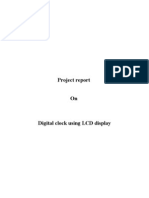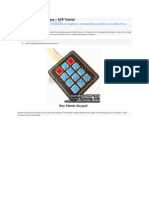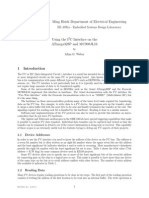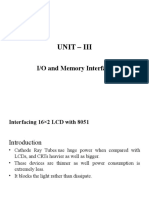03 Unit 9 Assignment
Uploaded by
Jeff Brown03 Unit 9 Assignment
Uploaded by
Jeff BrownJeff Brown Microprocessing Mr.
Hamza 08-01-13
Chapter 12: Problems 2-11, 13, 15, 17, 21-28
2. They are the control lines for the LCD. E is for latching information into the LCD, R/W is for reading from or writing information into the LCD , and RS is for making a distinction between the data and command. 3. Vee controls the contrast of the screen while Vcc provides power to the LCD. 4. command, 01h 5. 0Fh 6. RS = 0, RW = 0, E = H-to-L pulse 7. RS = 1, RW = 0, E = H-to-L pulse 8. (a) 9. True 10. Sending information to the LCD without checking the busy flag is very simple to write but the microcontroller wastes a lot of time in a delay subroutine. The advantage of monitoring the busy flag is that the next information is sent when the LCD is ready and there is no wasting of time. This is very critical, especially when the microcontroller is busy and must serve many devices. However, the subroutine for monitoring the busy flag is much harder to write and takes more code. To monitor the busy flag, we make the port D0 - D7 of the LCD an input port, read the D7 bit, and wait for low. 11. 80h is the starting location ,and 16 locations to the right is 8Fh. 13. 80h is the starting location, and 20 locations to the right is 13h which result in 80h + 13h = 93h. 15. If 80h is the address of the first location, then adding 39 (27h) we get 80h + 27h = A7h. 17. 89h since 80h + 9 = 89h. The 10th is address 9 since it starts at 0. 21. 1s 22. (a) 23. (b) 24. key 3 25. This allows the microcontroller to do other things. 26. Use a chip for the keyboard (for both key press and identification) and then pass the scan code for the pressed key to the microcontroller via a hardware interrupt.
You might also like
- MODULE-5: Interfacing: Microcontroller Notes:18EE52No ratings yetMODULE-5: Interfacing: Microcontroller Notes:18EE5251 pages
- Electronic Code Lock With User Defined Password Using 8051 Micro Controller0% (1)Electronic Code Lock With User Defined Password Using 8051 Micro Controller7 pages
- Electronic Code Lock With User Defined Password Using 8051 Micro Controller PDFNo ratings yetElectronic Code Lock With User Defined Password Using 8051 Micro Controller PDF7 pages
- Interfacing Example - 16 Character X 2 Line LCD: Description100% (3)Interfacing Example - 16 Character X 2 Line LCD: Description5 pages
- Unit - 5 8 Hours Interfacing Programming in C - 2: Pin DescriptionNo ratings yetUnit - 5 8 Hours Interfacing Programming in C - 2: Pin Description25 pages
- Parallel Port Programming (PART 1) : With CNo ratings yetParallel Port Programming (PART 1) : With C15 pages
- Simple 8 Bit 16x2 LCD Interfacing With PIC 16F50% (2)Simple 8 Bit 16x2 LCD Interfacing With PIC 16F8 pages
- Ds1307 RTC Relógio de Tempo Real - Pic Arduino Avr - 1 Peça100% (2)Ds1307 RTC Relógio de Tempo Real - Pic Arduino Avr - 1 Peça5 pages
- Government Polytechnic, Karad: Electronics & Telecommunication EngineeringNo ratings yetGovernment Polytechnic, Karad: Electronics & Telecommunication Engineering21 pages
- Unit - 5 8051 Interfacing Andapplications Interfacing of 8051with: Analog Sensors, Keypad & LCD Display, ADC, DAC, DC Motor. LCD InterfacingNo ratings yetUnit - 5 8051 Interfacing Andapplications Interfacing of 8051with: Analog Sensors, Keypad & LCD Display, ADC, DAC, DC Motor. LCD Interfacing31 pages
- CHAPTER 12 Real-World Interfacing I: LCD, ADC, and SensorsNo ratings yetCHAPTER 12 Real-World Interfacing I: LCD, ADC, and Sensors13 pages
- Interface A 2x16 LCD With 8051 in 8-BitSMP100% (2)Interface A 2x16 LCD With 8051 in 8-BitSMP18 pages
- Ece Project Report Arduino Based Time and Temperature DisplayNo ratings yetEce Project Report Arduino Based Time and Temperature Display16 pages
- Peripheral Interfacing + Coding: Lets Learn How To Do It in 8051 !!No ratings yetPeripheral Interfacing + Coding: Lets Learn How To Do It in 8051 !!44 pages
- IR Sensor Based Distance Measurement SystemNo ratings yetIR Sensor Based Distance Measurement System5 pages
- How To Use Intelligent L.C.D.S: Constructional Feature100% (1)How To Use Intelligent L.C.D.S: Constructional Feature0 pages
- Conceptual Programming: Conceptual Programming: Learn Programming the old way!From EverandConceptual Programming: Conceptual Programming: Learn Programming the old way!No ratings yet
- CISCO PACKET TRACER LABS: Best practice of configuring or troubleshooting NetworkFrom EverandCISCO PACKET TRACER LABS: Best practice of configuring or troubleshooting NetworkNo ratings yet
- Carrier Recovery: A Carrier Recovery System Is A Term Used For The Circuit That EstimatesNo ratings yetCarrier Recovery: A Carrier Recovery System Is A Term Used For The Circuit That Estimates3 pages
- Jeff Brown Strategies For The Technical Professional Mr. Harr's Class 11/26/13 Unit 10-Assignment 1No ratings yetJeff Brown Strategies For The Technical Professional Mr. Harr's Class 11/26/13 Unit 10-Assignment 17 pages
- We Can Use This Other Copy of The Table For Future Examination of Our Group in Coming WeeksNo ratings yetWe Can Use This Other Copy of The Table For Future Examination of Our Group in Coming Weeks1 page
- Jeff Brown Michelle Pultorak's Class CO2520T July 20, 2013No ratings yetJeff Brown Michelle Pultorak's Class CO2520T July 20, 20133 pages
- Unit 5 Assignment 1 - Intercultural Conflict Analysis: Jeff Brown Michelle Pultorak's Class CO2520T July 20, 2013No ratings yetUnit 5 Assignment 1 - Intercultural Conflict Analysis: Jeff Brown Michelle Pultorak's Class CO2520T July 20, 20133 pages
- Unit 5 Assignment 1 - Intercultural Conflict Analysis: Jeff Brown Michelle Pultorak's Class CO2520T July 20, 2013No ratings yetUnit 5 Assignment 1 - Intercultural Conflict Analysis: Jeff Brown Michelle Pultorak's Class CO2520T July 20, 20133 pages
- Unit 7 Homework Assignment Problems: Jeff Brown Microprocessing Mr. Hamza 08-01-13No ratings yetUnit 7 Homework Assignment Problems: Jeff Brown Microprocessing Mr. Hamza 08-01-132 pages
- Slew Rate: Operational Amplifier Dynamic Limitations Inel 5207 - Spring 2008 - M.ToledoNo ratings yetSlew Rate: Operational Amplifier Dynamic Limitations Inel 5207 - Spring 2008 - M.Toledo9 pages
- Nt1210 Introduction To Networking: Unit 5: Chapter 5, Ethernet LansNo ratings yetNt1210 Introduction To Networking: Unit 5: Chapter 5, Ethernet Lans55 pages

















































































